What to See, Experience, and Explore at Miami Art Week 2025
We checked in with our former podcast guests who will be inching through Miami traffic, unveiling new works, signing books and revealing new projects this year.
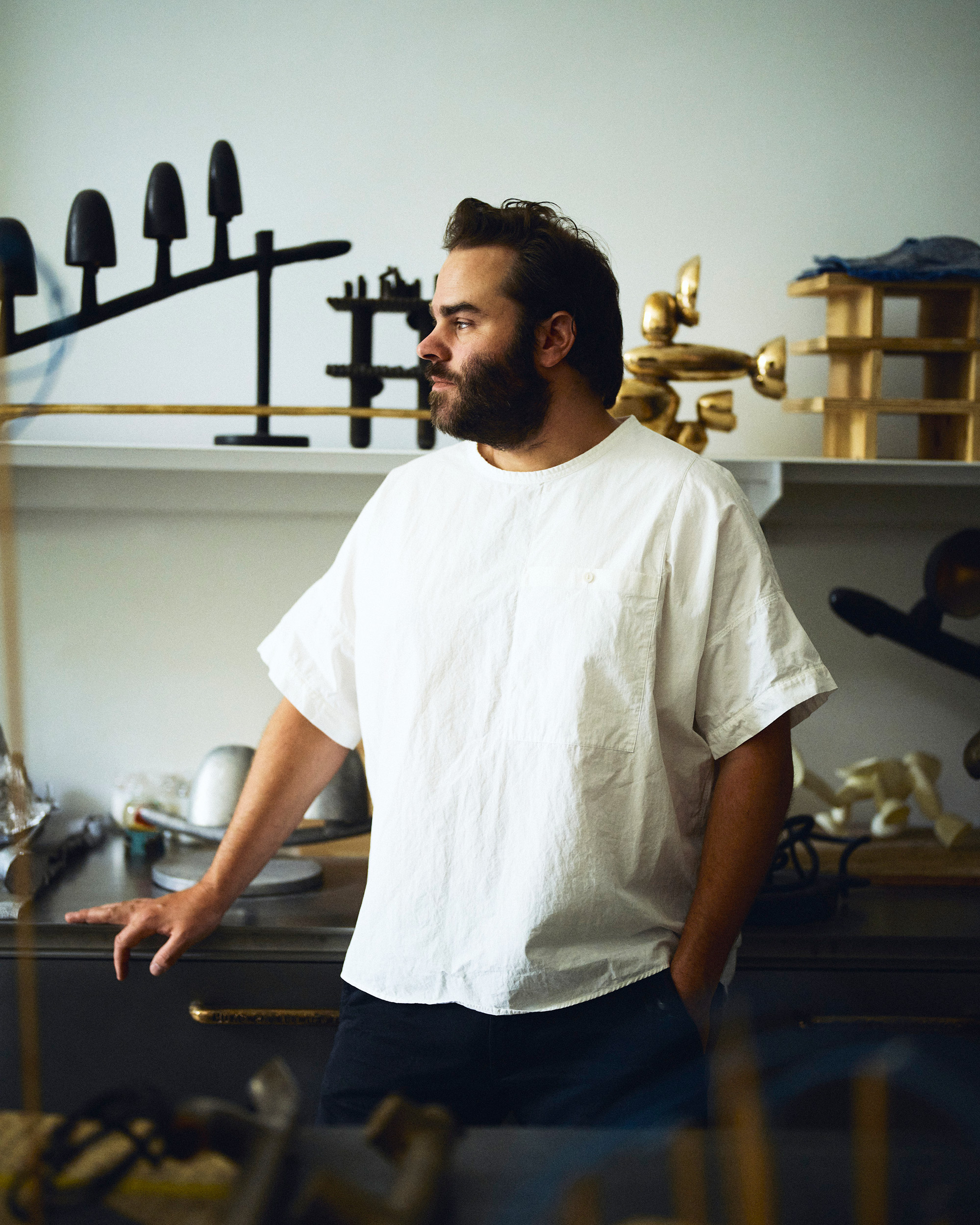
On this special episode sponsored by Lumens, Dan speaks with three incredible talents in the field of design: Pierre Marie, a French talent whose sense of color and artistic hand create everything from scarves for Hermès to fantastical works of crystal; Alyssa Kapito, a New York–based interior designer whose love of elegantly simple interiors is explored in her first book; and Frederik Molenschot, a Dutch genius whose love of the built environment creates mind-bending and monumental works.
For more information about Frederik’s works, visit Carpenters Workshop gallery.
TRANSCRIPT
Alyssa Kapito: One of my favorite things is to teach somebody how to collect and about the periods that they love, and show them that this stuff, while some of it’s expensive, don’t live with it in a precious way. You want to live with it. A lot of it is already a little bit banged up. Live with it, have your time with it, sell it, be part of its provenance. Just enjoy it.
Dan Rubinstein: Hi, I’m Dan Rubinstein and this is The Grand Tourist. I’ve been a design journalist for nearly 20 years, and this is my personalized guided tour through the worlds of fashion, art, architecture, food and travel. All the elements of a well-lived life. On today’s special episode of The Grand Tourist Introduces sponsored by Lumens, I once again explore the lives and careers of three emerging talents from across the design world.
But before we get started, a little programming note. This is, believe it or not, our 100th episode. A hardy thank you to all of our guests, our incredible sponsors, and most of all our listeners. You’ve changed my life in so many ways, and I hope that, in some small way, we’ve made yours just a little bit brighter. And if you want to keep this going, as I always say, please sign up for my newsletter thegrandtouristcurator@thegrandtourist.net, and follow me on Instagram at @danrubinstein. And leave us a comment or a rating on Apple Podcasts or Spotify. It makes a huge difference.
Now, back to a few introductions. Today, you’ll meet an interior designer from New York who channeled her love of the Renaissance into a booming career in interior design with an aesthetic well beyond her years. And you’ll meet an award-winning artist and designer whose luxurious lighting and other objects can be found in just about every triple A interior around the world. But first, I touch base with the design talent whose eye for color, pattern and craftsmanship are truly unique. Imagine rooms with vivid stained-glass windows, carpets in a deep mauve and cabinets covered in intricate floral like tiles, seemingly straight out of the Art Nouveau period. His name is Pierre-Marie Agin, but he prefers to go by the simplified nom de guerre, Pierre Marie. While his work started with pattern and illustration, it’s now grown into a full-blown studio exploring everything from lighting and furniture to wallpaper, ceramics and more.
It’s no surprise to anyone that looks at his portfolio that one of his biggest clients is the House of Hermès, where he’s contributed designs for their famous scarves for about a decade. And if you’re someone who admires stained-glass, Pierre-Marie is something of a savior to that near forgotten craft. His recent oh so intricate installation of the stuff at the Hermes boutique in Vienna, for example, achieved something oh so contemporary using the most ancient of techniques. I caught up with Pierre from his studio in Paris to talk about his process, his unique sense of color, a recent installation for the legendary Horta Museum in Brussels and more.
(MUSICAL BREAK)
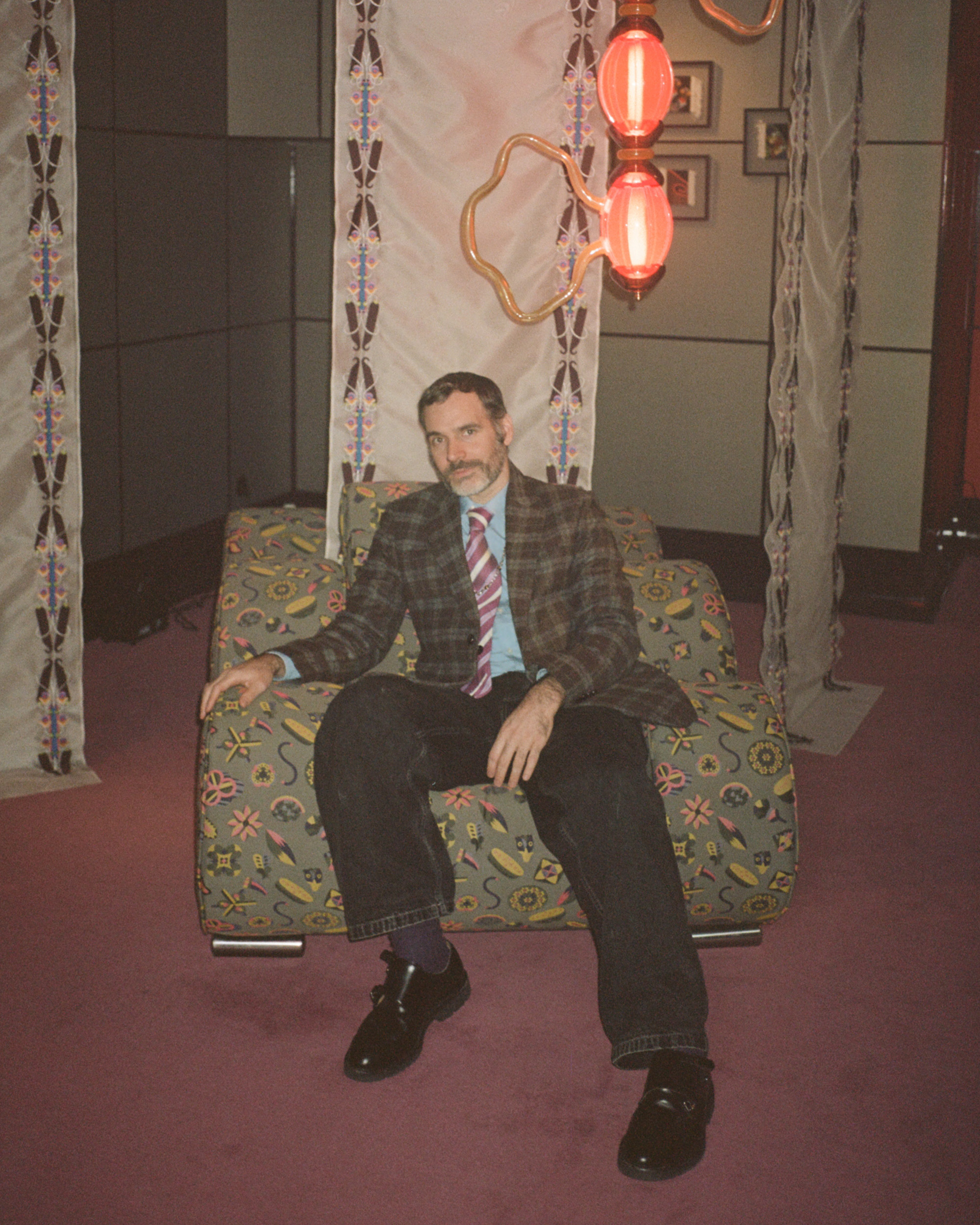
And I read in an interview with you, I believe it was in Purple Magazine, that your love of fashion started at an early age as a child. And I was wondering how did you develop that? How did that happen? Do you remember your earliest memories of fashion in some sense?
Pierre Marie: Yes. Well, I was born in ’82, and so, being close to Paris in ’82, someone like Jean Paul Gaultier or Thierry Mugler, they were very much in the media already on TV. The result is that, even as a kid growing up in the suburbs, you would know them and you will see their work. And I think I recall how through entertainment also the work of them were very out there. For example, Thierry Mugler, I’ve learned that after, but he designed some of the costume of one of my musical for children that I really liked.
Oh, really?
Yeah, called Emilie Jolie. And also he designed a lot of costumes for Mylene Farmer, and obviously I was a fan. So, that’s my background, loving fashion because it was all over me but without knowing it and without being able to pointing it out. Later, I was hanging out with my friends as every young kid from the suburbs in the area of Les Halles. And at that time, Rue Etienne Marcel, you had all of the Japanese designers like Yamamoto, also Comme des Garcons, and I think that was my first shock in terms of fashion. And I remember all of my straight friends from… They would go to a place where you can buy an outfit to look like a skater or something, and I would just stop by Comme des Garcons and say, “Okay, leave me. I have something to do here.” And obviously, I could just do window licking. But already, some of the salesperson, they were very nice with me and they explained me a bit the brand, and it started to become kind of an obsession at that time.
And how did that love of fashion evolve into design as you got older?
It’s because I think fashion was the first place where I was able to do my work. And I was close to young designers at that time, and they needed someone to design a cool invite for their first show. And you have to remember, it was the late nineties, beginning of the Y2K, and it was all about young designers at that time. And so, you could have zero money and we show in Paris and all of the big press would come and some buyers from Japan would buy all of your collection. And it was very different time then. And so, I started doing graphic design for some of those young designers and after, they asked me like, “Oh, but can you design a print for a dress or a jacquard for a knitted sweater?” And so I think this is when it first started, I realized that I was really into putting my design into materiality somehow and through a technique. And if it’s printing or embroidery or knitting, this is what I really liked.
And so, when I bought my first apartment in Paris, I remember thinking that I have to do the same thing for my interior, meaning looking at the crafts out there and see which one would need my drawings and see how it can be a good fit. And then, I realized that what I was doing has a very specific name in architecture and interior design, and it was ornament. And this is when I started calling myself an ornamentalist, a bit just to put it out there and to see how it looked. And it was interesting because some people were a bit shocked, what does it mean ornament? I thought this was a crime, this was forbidden. And some people were saying, “No, but you’re just a graphic designer, you’re not a ornamentalist.” And for some reason, I think it’s always good to be able to try at least to define yourself with your own words and then trying to have something to say something personal.
And what was your first big break once you started to call yourself an ornamentalist? Because I know you’ve been designing scarves for Hermès for a long time now, but before that, what was your first work that you would consider yourself as your studio?
Hermès, I’ve been doing it for 15 years now, and it kind of helped me to go through that process of understanding what I was good at and what was the meaning of my work. But it was a little after, using my own apartment as a place of experimentation, that I really realized how, for example, designing a stained-glass or designing a tapestry was a childhood dream, but that rejected at some point or when I was younger. Because for me it was like, “No, but you love stained-glass and you love tapestries, but you are not made to learn the technique, first. And also, maybe this technique belonged to the past and it’s only in castles or church that you will see such techniques.” But then, I discovered, by researching, and especially being in that very 19th century and a bit Art Nouveau neighborhood in Paris, I made a lot of research about Art Nouveau.
And I discovered that actually, before modernity take that turn to the right or to the left, was still possible to imagine that modernity would be about renewing with Middle Age for example, and that someone like Viollet-le-Duc, will just write a book saying that the modernity is all about putting stained-glass back where it belongs on the top of architecture, and that every modern building should have stained-glass. So this was a revelation for me to say, “Oh, everything is connected, my childhood dream, what I know now and what I want to do in the future.” And this was the first big experiment in my house.
And what is your process like today? Because you work in many different mediums and you work with a lot of different craftsmen in terms of stained-glass and wood and everything, and textiles. Tell me a little bit about your process and how do you… With anything, does it start on pen and paper or how do you work?
Yeah, it starts with pen and paper, absolutely. And then, it’s also like gardening in a way, where you have to take care of every little parcel of the land and every plant request a different treatment and some different attention. And so I have the global idea in mind, but the process of getting it out there, knowing that I need, most of the time, the intervention of makers or artisans, it means that you need to put that global idea out of your mind. And the best way to do that is to sketch it and to design it. It’s a way of following the red line until the end of the process. And sometime, for these kind of projects, it can be two years or one year, and so it’s quite long. It’s also something very new for me, because when I used to do only prints, especially in fashion, it’s really fast, which I like. But I also like this idea where you are following the same vision for two years and trying to pushing it. It’s very nice too.
And your sense of color is very unique and it’s very identifiable, even though I couldn’t describe it to you. And I’m wondering how you… I just don’t have the correct words for it.
No, you shouldn’t!
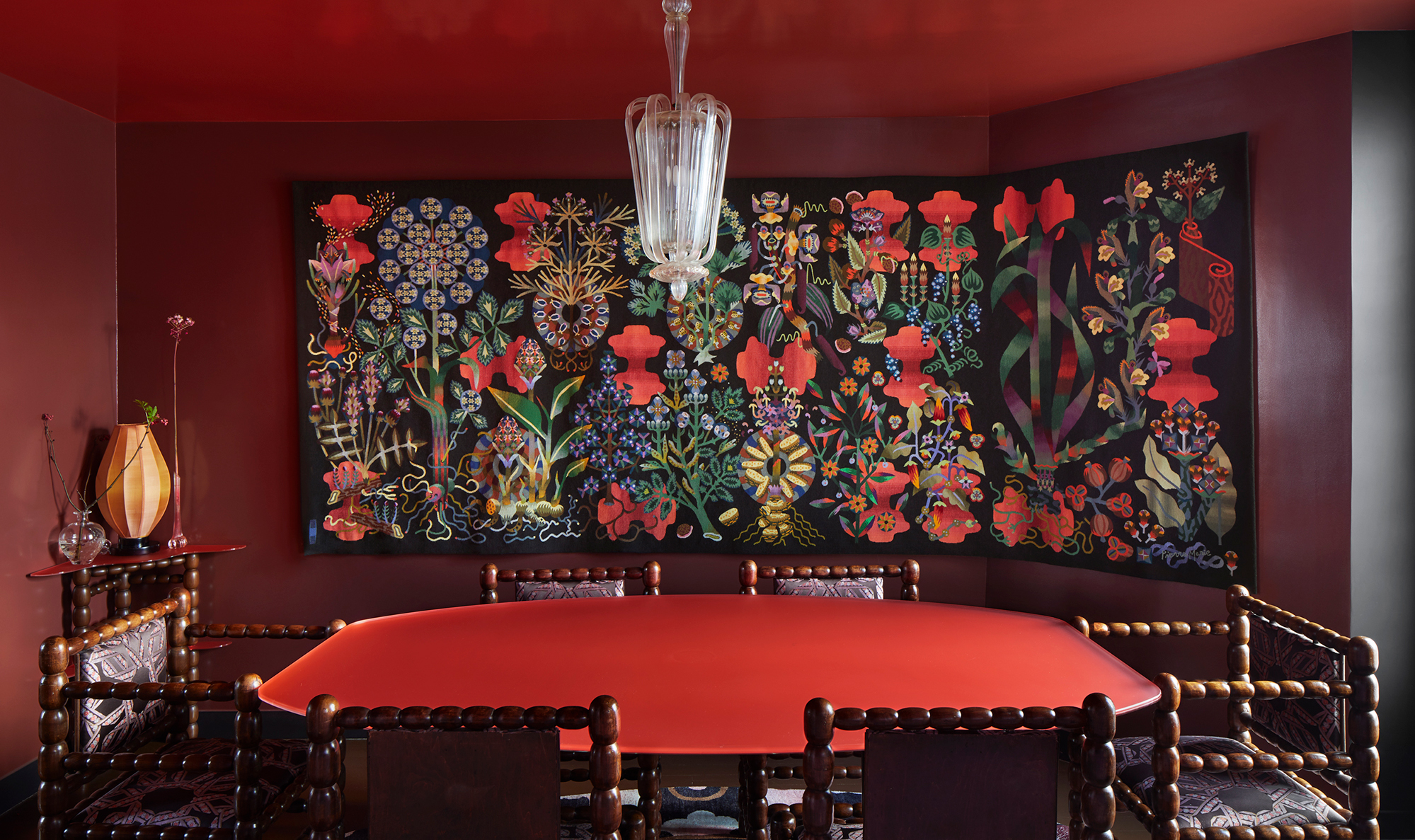
And I wonder, can you describe either your palette or the way that you think about color or how you work with color?
For me, it’s all about creating a unique… First of all, people think in terms of color, sometime one color, and they think, “Oh, it’s bold.” But one color can be very bold or be very plain. It depends which other color you put it next to. And so, for me, it’s more like always the idea of a palette. And I like that it drive your attention to a very specific mood, but also that it’s soothing you always. Meaning that I want to create the surprise, but also I wouldn’t like a palette to be that extreme that you would feel uncomfortable or you would feel like someone is yelling at you or holding a sign saying, “Look at me, I’m colorful.” I like the idea of something that kind of brew or infuse your brain and your eyes, and that, all of a sudden, you are not looking at the colors, but you are part of it. It’s more like playing with lights than with colors. I don’t know if that makes sense.
Your wallpapers are quite beautiful, and obviously, it’s a natural outgrowth of your work and it’s in some ways in an obvious way, but also in a very beautiful way in the way that you approach it.
Thank you.
You had a project at the Horta Museum, which is a historic Art Nouveau house in Brussels. I’ve been there, it’s quite extraordinary. It’s a very well-preserved, I’d say large, large townhouse, both inside and out. And can you just tell me a little bit about this house and what you did for it? Because I think it exemplifies your work a lot.
Thank you. I first visited that house as a tourist, and they have a no photo policy, which I understand, obviously, but also always makes me super mad when I’m in love with a place because I am like, “No, but I’m not a tourist. I need to take notes. And it’s such an inspiration.” And so I was like, “Oh, at some point I need to write to them and to say I want to come back and to study and to be able to take pictures.” And I didn’t have to do that because the director of the museum once wrote me and asked me if I wanted to be part of a group show called Pushing Back the Walls. And the idea was to create wallpapers for every room of the house. And obviously, they had one artist per room. And I was a bit sad about that because, you know me, I wanted to do all of the rooms. So it was the best because I had the opportunity to go back to the house, being alone in the house, and I could take as much picture as I wanted.
And it’s such a special house for me. I recently visited another of Horta project in Brussels, and it’s very different because it’s one he did for some of his very rich clients, but I’m very moved by the one he did for himself. And this idea where everyone, every architect, every interior designer, at some point, has to test his big ideas for himself. You have to be your first lab rat somehow. And it was very moving to go there and to be able to spend a lot of time in that house. Every house, every place has a spirit somehow, and you just have to listen to it. And this is something I love doing, for me, to be very respectful of the past and never try to push my style by being in rupture with what’s already there and being like, “Oh, but no, but I’m modern and I’m contemporary and I will just do my own way.” No, I really want to brush… I don’t know if you say that in English, but we say to brush the air in the good direction. I don’t know if that sounds funny.
No, but we don’t. But I understand what you mean.
It’s like being aware of the context and use it as a very powerful tool to pin it somehow.
What’s next for you?
I’m presenting a project I really love in April during Salone del Mobile in Milano. It’s a collaboration I did with the crystal brand, Saint-Louis. It’s a manufacturer that belongs to Hermès that is famous for crystal. And I’ve been designing three exceptional pieces for them. And the idea was to renew this heritage they have of decorative arts and pieces that are just decorative and beautiful and try to forget, for a minute, the idea of function and why does everything needs to have a function and why do we need only lamps or glasses to drink? But sometimes, with this kind of fabulous technique and very specific technique, it’s also beautiful to create something that is just about daydreaming and just being beautiful. So this is something I’m looking forward to and I’ve been working on that for seven years, actually, believe it or not. It was a long process.
(SPONSOR BREAK)
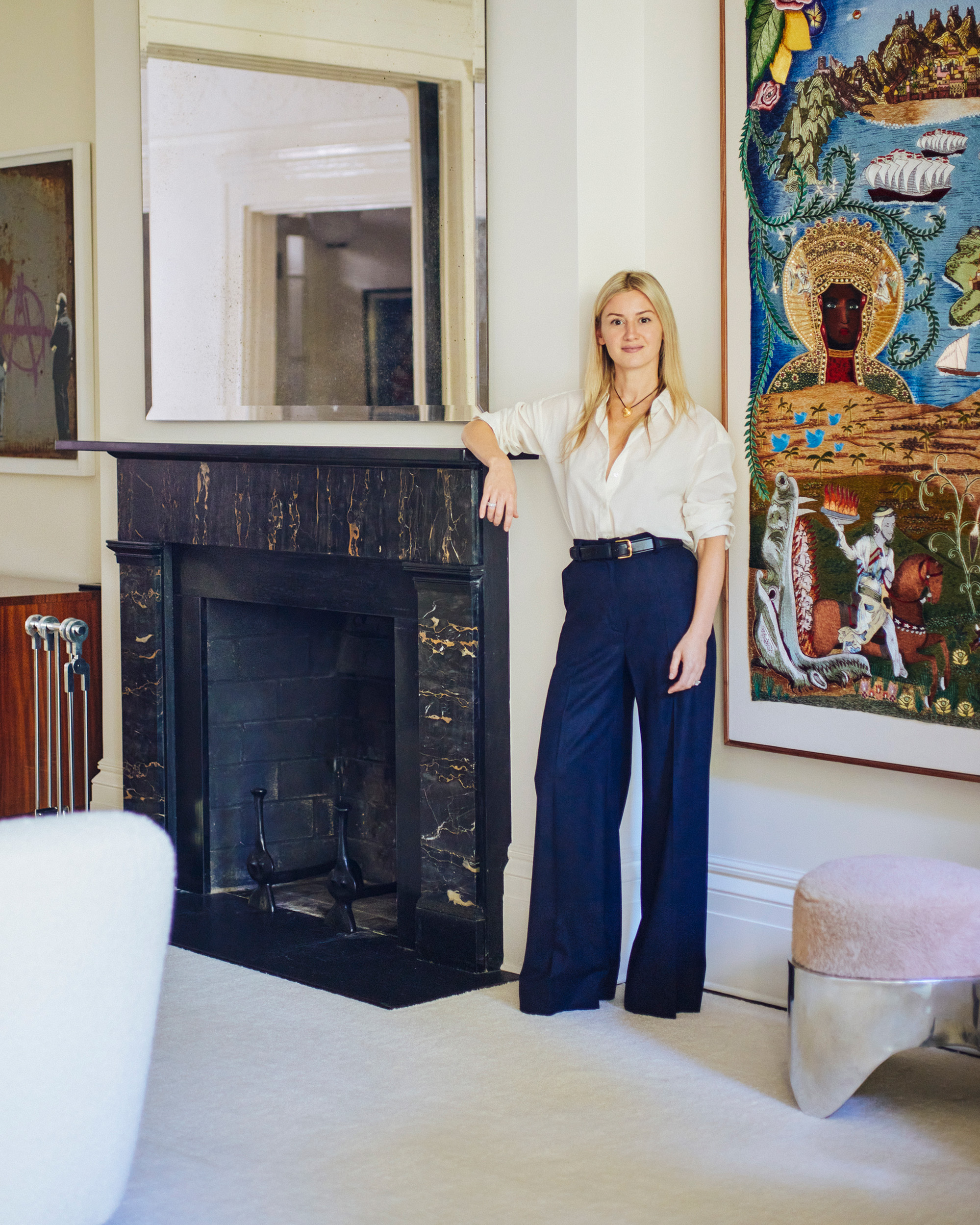
My next guest exemplifies a generation of decorators and interior designers in New York whose aesthetics are proudly dated. Let me explain. For many upstarts in this world with a super wealthy and discerning clientele, they’re not looking to dazzle anyone with youth culture, wild colors, insane ideas, or, heaven forbid, work that looks like it was from the pages of a supermarket checkout magazine. Instead, they look to design heroes like Jean-Michel Frank, the pre-war designer whose ideas on proportionality and other things resonates with a generation that’s looking for interiors that exude calm and elegance.
Alyssa Kapito is one of those champions. She studied the art of the Renaissance in school, but then switched to decoration for a career that was better suited to her passion for conversation, collaboration and curation. After getting her start with the immortal designer, Bunny Williams… More on that later… She had a brief studio with a collaborator before setting out on her own. Today, she has a thriving business, a new gallery dealing in collectible design and her first monograph to boot, Alyssa Kapito Interiors. Out this month from Rizzoli, I caught up with Alyssa from her home in New York to chat about Leonardo da Vinci’s most famous book, why working for Bunny Williams was truly eyeopening, her love of all things Jean-Michel Frank, first cousin once removed to Anne Frank by the way and more.
What made you want to study art?
Alyssa Kapito: My mom was a lawyer who wanted to be an art historian, and she really noticed that I took an interest to it. My book that’s coming out in March is actually dedicated to her because she really, really encouraged that part of me. But then, when I was in college, and after that, it somehow… And I can talk to you about this more, but it became more of a interior’s lens through which I saw art and that’s how I ended up here. But it was really my mom who… I have the best mom. She’s great.
Hi, mom.
Hi.
And when you were studying, you specialized in the Renaissance, what made you want to go there? Was it just sort of maybe perhaps the most, not obvious, but obviously the big beautiful part of the art world? Is that…
Well, besides it being incredibly beautiful, the Renaissance is a wonderful period to study in a school setting. It’s incredibly analytic. It’s the first time that art is being treated as art. And so it’s the first time the conversation is happening that, this is an artist, how are we approaching this different than a tradesperson? What is it that makes an artist an artist? And that question was something that I found fascinating. What makes something that’s every day into an art? Interestingly enough, it relates very much to what I do now. I work with an everyday palette and it’s what makes it an art. So I loved studying that from a philosophical perspective. And also, I had a great professor and sometimes that could be the thing that turns you onto something. I had an amazing professor and she just really-
Where did you go to school?
I went to Columbia for undergrad and for graduate school.
Oh, amazing. And I read in your book you describe that da Vinci’s treatise on painting influenced you. And I did a little bit of quick Googling and was interested to… I’d never heard of the book before and the book mentions treatise on painting, it was a very, if not the first book that treated painting as a science and as well as an art form. So, why did that book touch you so?
It was fascinating. You grow up thinking that artists were always artists, but these people were tradespeople and Leonardo da Vinci, who we think as one of the greatest artists of all time, was essentially somewhat of a tradesperson and he was the one to really write on the artistry of what he was doing. The fact that everything about an artwork is going to influence the viewer, and just this really lofty sense of what they were doing, that it really surpassed what they had been known for. I just found the whole idea of the artist fascinating. There’s also all these conversations on melancholia in the Renaissance, which talks about the artistic brain and the anxieties that that produces. It just was so interesting to me, and I honestly thought it was so beautiful. But they’re so much in Renaissance art that’s symbolic. It was just a bunch of genius minds and just you respect the genius of it. So it was really the first time. So I just found it fascinating. I love it. I could talk about renaissance art forever.
And when it comes to your obsession with interiors, I read that you got an internship with Bunny Williams, is that right?
Yeah, that was my first entree into the interior design world. So I was living in Boston at the time because my husband was in business school and I was doing my thesis in Renaissance art, and I was in the stacks with nobody. And I’m a people person, I just thrive on being with people, and I was spending all my time Googling interiors and I was a bit miserable because I had gone from a classroom setting where I was around a ton of people, and then I went into the stacks to do research where, that’s really where a lot of your career as an art historian takes place. And I was like, “This is so lonely. I feel so isolated.” And my husband was like, “You love interior design. Everything you do and everything you want to see is interior design. Why don’t you try it for the summer?”
And the funniest thing that he said to me, which I think is actually really important, he’s like, “All you do is Google interior design.” And every time somebody is like, “I don’t know what to do with my life, I’m so lost.” And I’m like, “What do you Google? What’s the thing that really interests you that when you go home at night, you still have the energy to Google and research?” And for me, it was interior design and I was just like, “Okay, let me try this for a summer.” He had a break between his school. Like, “Let me try this for a summer.” And I went to intern at Bunny Williams and it was like brain explosions.
I was like, “This is everything I always wanted.” It definitely has an element of the arts, and yet you deal with people and just being completely surrounded by beauty for me and creating that environment, it combined a lot of things. It combined the art, it combined the fine arts. As a child, I was really into drawing and painting. I still am. And it was just, for me, a whole package. So I ended up interning there and I loved it.
And what is Bunny Williams for people who don’t know, as there are many listeners here who are from outside the US? She’s a legendary interior designer, gardener, sort of a domestic goddess. What is it like to work for Bunny?
So one of the most interesting things about working for Bunny, which I think I’m really lucky to have seen as my first experience, because I think you can work for a lot of interior designers who don’t have as big of a business sense as Bunny. Bunny runs a really serious business. She has an incredible design firm, she has a furniture line, she organizes her office in a really interesting way in terms of, there are project managers, and it’s very organized. And I didn’t take it for granted, but I think you could take that for granted if you had never worked anywhere else, that she really works in a way that’s incredibly efficient. And while our styles are not similar at this point, the way I ran my business was definitely modeled off of that first example that I saw, which was with her. So that was incredible.
That’s amazing. Because I was going to say your styles are now kind of diametrically-
So different.
Opposed in a sense, but she is a legend in the fact that she’s been going all this time. She also has a new book out, I believe. Shout out to her, if she happens to be listening. And if you were a part of a generation of designers that I would say have a somewhat similar outlook or a list of heroes, I would say, I would point out, you mentioned in the book your love of Jean-Michel Frank.
Oh, my God.
And your reference to him. And I have one more designer, one more designer comes and tells me-
You’re flattering me. I’m blushing.
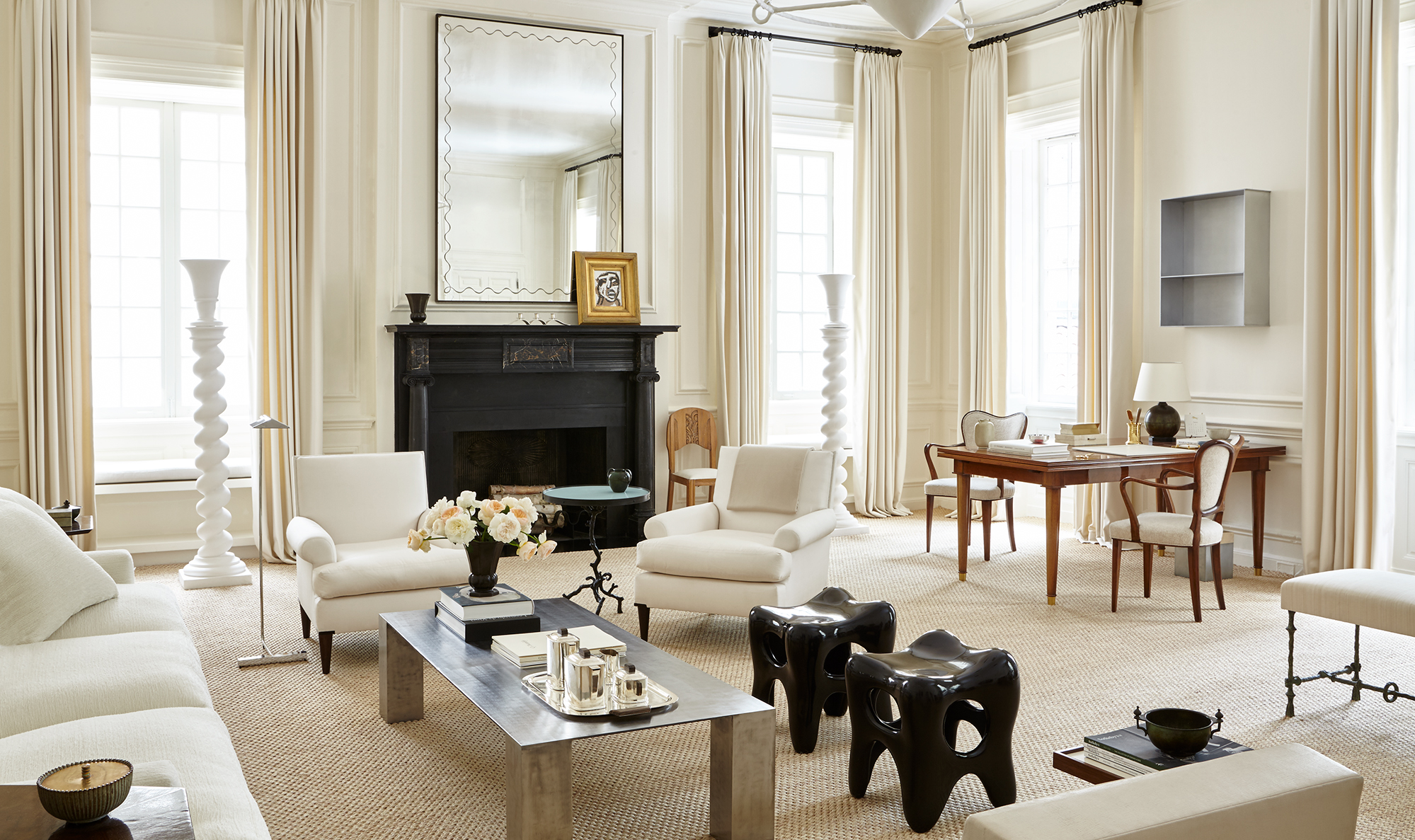
One more designer tells me, “Well, I’m going to challenge you.” Because I’m like, “Oh my God.” Every designer of a certain stripe references Jean-Michel Frank nowadays in a way that no one did maybe 10 years ago. What is it about this man? Explain it to me. Of course, his work is amazing and he was very influential. But what about it specifically do you keep being like, “Oh my God, this is amazing?”
So the thing about that school in that period, and especially Jean-Michel Frank, is that he was a master at using uncomplicated forms with elevated materials. That’s something that really, really resonates with me. So you have a box, but it’s made out of straw marquetry, and the material and the texture is what comes through. So that’s number one. There’s also scale about his work that’s just so admirable. He was just a master at using scale in that. Just understand, so many designers miss scale. They have a room with big furniture, they have all the furniture at the same eye level. Scale is so important for that oomph that just makes a neutral interior something truly remarkable. And then, his last thing was editing. He was a master at editing and knowing when to not use something. The voids in his work, to me, are just important as the areas that have the sofa or the areas that have the desk or the lamp.
He knew when to cut it down. And I think that’s something that I always remind myself, you can bring in a lot of accessories and then you have to know when to take them out. Just because you have something doesn’t mean you necessarily need to use it. So all of that, the scale, the proportion, the use of incredible materials, those are things that really, really resonate with me. There’s a simplicity to my work that comes from, I think a desire for my brain to be in a space that is uncomplicated. But I think that could get a bad rap for being boring, but it’s not boring because there’s something about it that’s really thoughtful. And those are the things, for me, that are really thoughtful, that take a space from being boring to being really memorable. And so, whether or not you realize it, I think most people who look at his work don’t realize why they love it so much. And his birthday is coming up this week. I know that because he shares the same birthday as my daughter.
Oh, okay. Well, happy birthday, Jean-Michel.
I’m not a fan or anything.
And is there a particular project in the book that you think really exemplifies your taste or your approach to design the best?
I think the interesting part of it is the fact that a lot of it represents different moods that I had and different spaces with different personalities. And so it all really feels very much like me and my clients, but it’s me in different forms. It’s like you wake up one day and you want to be The Row, one day, you want to be a little grungy. None of my work is grungy, but it’s definitely-
I’m scrolling through the book right now and I don’t see anything grungy.
Definitely, the fun part about what I do and what I love is that the projects are influenced by outside factors. And so I get to be me in different forms. So they’re all really versions of me. And one is a city version, one is a house version, one is a really French living room with 14-foot ceilings. But it all feels like me. I’m proud of them all. They’re all my children.
Do you think that there’s something uniquely New York about your work? Aside from the fact that a lot of them are in New York, but is there anything particular about as a Manhattan point of view?
I do do a lot of New York apartments, and I think that I really enjoy it because I think I like the limitations. Otherwise, I can just endlessly be in it. But I think if you asked most Americans, I think they’d say that my work is a bit European. And I think if you asked Europeans, they’d be like, “Oh my god, it’s so New York.” So I don’t know where I land. Somewhere in between.
And we spoke a little bit about your love of Jean-Michel Frank, and this generation of designers that are coming up in the world that all reference him. And I was curious, what is it about this period and this aesthetic that you think appeals to you in your generation? If I got all of you guys together-
I would have my generation—
Which would basically be designers living in New York in their thirties, essentially.
That’s a good question.
Are you rebelling against something?
I’m not… Well, maybe. I grew up in the house of chintz, which my mom had incredible taste, but it was like, tell me you were born in the eighties without telling me you were born in the eighties. Chintz was everywhere in my house, and so obviously, there is no pattern in my work, though I love my mom’s taste, so I don’t know why I ended up that way. But I do hope it’s not Instagram that’s making everybody the same, because there is a little bit of that Instagram fatigue that you see a lot of things on Instagram and this whole idea of quiet luxury. But I think that it speaks to a very contemporary lifestyle. It’s easy, it’s easy to live with, which is what was so modern about Jean-Michel Frank, is that he was designing in the thirties and he was really such a visionary. It just feels more simple in the way you live and the whole aesthetic of The Tow and I don’t like the term quiet luxury.
Why not?
I just feel like it’s been overused in this cheesy Instagram way. But there is something really beautiful about focusing on the materials as opposed to a pattern, logo, all that stuff that I think some of us grew up with, especially in Long Island, if you grew up there. This idea that you just want to live surrounded by a bit of simplicity. Also, the world we live in is so overwrought with stimulation. I just find the place that I live, I want it to be somewhat simple and not overwhelming. I find our phones, Instagram, social media, the news, it’s all bombarding you. And I want space to think in your home. I want it to be a very calming place. I think it’s what I crave and what my clients crave, but I also want to be surrounded by beauty. So I think that speaks to a lot of people today. I think they just want to… There’s a simplicity that people crave in their homes.
How many kids do you have?
I have three.
And boys or girls?
I have a boy and girls.
And do you find yourself teaching them anything about art and design?
Oh my God, absolutely. I have the best photo of all time. I took them to the Sotheby’s Important Design, and obviously, I’m friends with some of the people there and they let them ride on the Lalanne, the outdoor Lalanne sheep. So I have an amazing picture of my kids just riding on the Lalanne sheep in front of the Important Design. So absolutely, I drag them to all that stuff.
Any kid riding a Lalanne sculpture, at this point, makes me nervous just as they’re half a million a piece, easy.
You know what? They’re actually made for the outdoors and I was so nervous. I was like, “Are you sure they can do this?” And he’s like, “Yeah, they’ve been through the outdoor, a deer has licked them. They’re fine.”
(SPONSOR BREAK)

My final guest today is someone whose work would be immediately recognizable to any fan of luxury interiors. His Citylight series of chandeliers and other lamps are often cast in one long spiraling swirl of bronze and combine an organic feel with a cold, monumental appeal. Dutch designer, Frederik Molenschot. Frederik, studied at the Design Academy, Eindhoven, one of the best in the world, where he studied the relationship between man and the urban environment. He considers his works to be landscape sculptures. Some of his other works resemble a tower or a suspension bridge. Others resemble a roller coaster. His ability to take complex ideas, shapes and concepts and distill them down to elegant objects with deep meaning show a true talent that isn’t likely to slow down anytime soon. I caught up with Frederik from his studio in the Netherlands to talk about his early career, why one of his more humorous works are inspired by wheels of cheese and how a humble sweater has surprisingly become a signature of his.
You’re Dutch, correct? You’re from the Netherlands originally? Yes. And so I’ve read a lot about your work, but tell me a little bit about what you were like as a kid. Where did you grow up? Did you grow up in a suburb or in a city? What was your youth like?
Frederik Molenschot: My youth was very stormy and—
Stormy?
Yeah, stormy in a negative and positive way. But I think I’m born in Breda in the south of Holland, which is not a really big city, but not very small, right next to the factory of my family, which was casting iron scales for over two, 300 years.
Oh, wow.
And then, my parents divorced when I was just a month old. Then mom moved out, and then, until I was seven, I went back in the weekends to see my father. So I was only the weekends in this environment of that factory and seeing my dad. And that was, my young years, had a very big influence on my whole life. So I think heritage is something… That heritage never left my scope of thinking. And on my mom’s side, the family owned factories in leather tanning, which is imported from Brazil and everywhere. So producing and having this industrial craftsmanship surrounding around me is something that’s in my genes.
And so when you graduated from Eindhoven, what did you do? What was your early career like?
The first thing I did was making a children’s book about my own upbringing, so the way my parents divorced and the subject why they divorce. So it was a very, very therapeutic first project. And afterwards, I started working freelance for different companies, sculptors, commercial companies, a lot of brands and things. And I worked for many years for Siemens Mobile in Munich and Shanghai. They had this program called Design Lab where they invited many people from all over the world to work around the subject communication and architecture. So I was working back then for the mobile division of Siemens in this Munich office. And also, that started actually the whole story of the light sculptures that I’m so well known of, that I produce for all the Carpenters Workshop shows because the first one was a maquette of Shanghai, was reflecting the highway structures, for me, to move from the site of Holland into this city, Shanghai, where 16 million people lived at that time. And the Netherlands also has 16 million people in the whole country, so it was a huge culture shock to see how the infrastructure was transformed in Shanghai.
To understand this, I would buy maps of Shanghai and just walk lines and lines and lines on these maps, taking pictures on all these corners of streets and just registering the city. That’s also a thing I did in the Design Academy. I studied men in public space, which is a department where every design process starts with a research within the public space. So all we do is absorbing public space, absorbing the world, absorbing people how they behave, and try to get information out of this. And that information transforms itself into an analyze and to a sculptural object, which is, in my practice, always based on modules, on repetition, on trying to get these 3D diagrams, which I call sculptures. But they always start as a diagram, as a little part of information of how we, as people, behave in a public space.
And is that where this idea of calling what you do as a landscape sculptor, is that how you connected this idea of places like translating places like Shanghai into-
A sculpture.
Yes. And so why that term specifically?
So the term started actually when we worked with Carpenters for the solo show we did in Paris was always the discussion between art and design. Also, we spoke before this interview together about all the things that you do. You’re never one principle. And even within this world as we live in now, it’s hard to be exactly only one rigid functional man or woman in a society. You need to be everything. You need to be so many different people, so many different cultures. So automatically, you start to combine all these different ambitions. And so for me, growing up next to this factory in this industry, seeing crafts happening, then going into my early youth, seeing art, seeing sculpture, seeing all the old European art disciplines, then going to Design Academy, not even my direction, the department public space was not about creating a chair or an object. It was all about creating a research to find definition within the world.
So when I stopped the academy, I never made any product. I never made any sculptural object. When I stopped school, I have very mixed feelings. Like, what am I today? Am I a designer? Am I an industrial designer? Am I an artist? Am I a researcher? So after working for 20 years in my practice, I found out I was a landscape sculptor because most of the projects, when I look back into the timeline, were always starting within the landscape, were always literally objects that I would transform into my own typography, my own archetype, and then would place them within my workshop into another object. So it was always this game of pulling the world inside into my studio and then starting to play with it.
And when it comes to these chandeliers, sculptures, lighted sculptures or chandeliers, as most people know them, I think there was a period where, now, as someone who looks at a lot of interiors, it’s been so successful and you’ve had lots of different iterations and-
People call them mushroom lights sometimes.
Mushroom lights. And they do kind of look almost fungus-like. And you’ve used similar technique to create a table, to create a vertical chandelier or a horizontal one. How did that particular series first begin as a product? Was that something that you created in tandem with Carpenters [Workshop] or how did that come to be?
Yes. Yes, it started to grow within the collaboration of Carpenters, because in my own practice, every week, we make something new. If you would… Please feel invited to come over to see this in real, but there are so many little stories in this building. And I think this piece, for me, it’s been an adventure to find out that one specific design can have so many forms, can have so many houses, can have so many stories. And even every year, the first one started as this maquette of Shanghai, and now it transforms into this iconic, monumental light sculpture, which people see as a totem above their dining table or within their homes. And for me, in the beginning, it was really hard to understand why this happens. I was never trained or never had the ambition to create one specific language and then make this for almost over 10 years now.
And so it took me a while to understand this process. It took also, in the beginning, it was super special to have something which was a success, which gave me a financial backbone into my practice, and it helped me to have this freedom to create my work further, other works. And also, within the Citylight, I’m sitting right below one now, which you can’t see, but I’m sitting in this golden glow every night behind my computer. I think it’s this piece has a different definition every year. So even when it’s within projects, I can see it sometimes I’m like, “Wow.” It kind of transforms into something else when it’s combined by an architect within a different space, or when it’s hanging in this concrete empty block, or when it’s hanging in this totally over decorated French interior. So every time, for me, it is made in this workshop downstairs, concrete floors, white walls, brick walls, half paint everywhere and it’s a real adventure.
I really dive into the wax, I dive into the pieces, every time, it’s a serious game. No one buys a piece from us, which is not taken super serious because I want this… The sculptures also transform every time. They become more difficult within the production, they become more sophisticated within the wiring, everything. So it’s a continuous battle between the design and the arts and how to manufacture it and to get the materials. I think we see so much items on Instagram, if you and I scroll down the gram, it’s endless. It’s unbelievable how many objects people make every day. Not even talking about what’s happening in China, like iPhones, everything, but also artists. There’s so much demand for objects and that’s something that I’m still running behind on, to grasp it. And then, one of the most important lessons I had about this to understand it was from Erwin Wurm, which you also had in your show.
Erwin Wurm.
I asked him, “So how can you produce so many years? How do you feel about it?” And for instance, he makes this fat car or this fat houses, and he says this is a subject for him. And every year it relates to something new that happens in the world. So, when I came back from that visit, it gave me so much relaxations about what I’m doing and what we are doing in our studio that you can work like a monk and define your objects better and better, but it will have, for yourself, a different definition every year. But also, the person who sees it or who buys it has a different definition about it. And this all makes it super magical for me. And when people starting to have their own stories about pieces that come out of the studio, that’s like then the job is done.
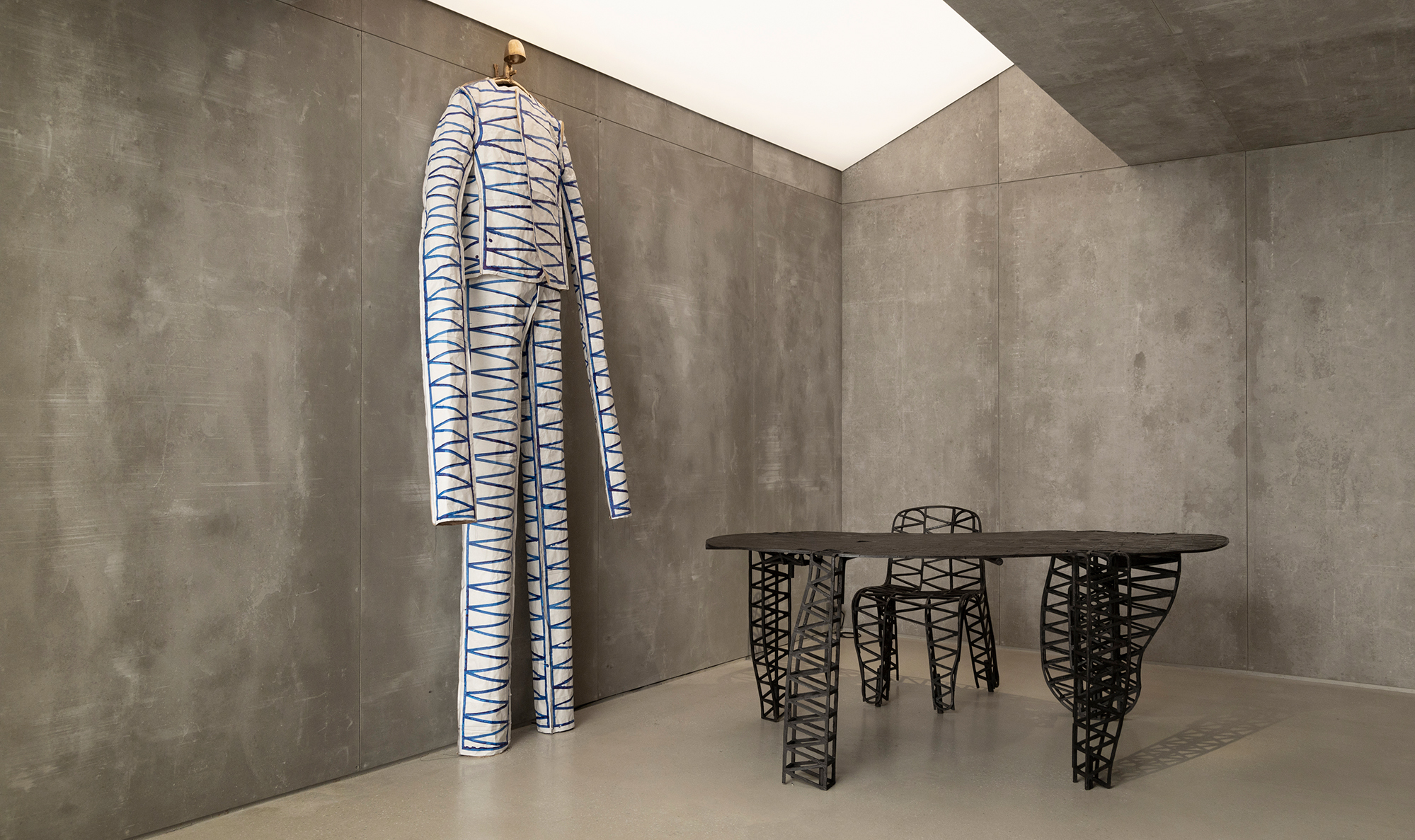
And as part of your Atlas 2000 project, you had this amazing sweater that has become a beautiful extension of your work. Tell us about this sweater. It’s essentially a white sweater, but with extremely long arms, I would say, I don’t know, 10 feet or something. Way longer than you would normally need, and drawn on it is like a scaffolding kind of very basic shape, like a bridge. Right? So tell us about this.
So this project is about identification with the object. So it’s like you being next to any sculpture you see, or any tree, or any bench, or any piece of concrete, or any rock, or any pile of mud, everything you will see around you is material. And I’m not sure if you have it the same as I have, but if I see material, or if I see an object, or if I see a pallet with blocks, I kind of start having a conversation internally with this thing. So everything I try to do is that, pieces we make starts a conversation with you as a human being, and then literally also your size in comparison to that object. So how do you see yourself in comparison to materials, into buildings, into bridges? So the sweater is this one-to-one symbol for becoming part of an object.
It’s very literally, and also it’s the big urge I have to work and to produce things in China. As when I worked in Shanghai where I started to do the practice that I run today, I wanted to go back there and to work with GT who is the person who produces sweaters in Shanghai. And I wanted to have this relationship with the production onsite in Shanghai to make a series of sweaters and also to get not… It was first started to sit in a chair with the same pattern that kind of stamps on your back. And then I wanted to make it into a paper suit, which hangs here in the studio. So it was only a sculpture. And then I started to see that paper bag, which all these things, wear it. I made a hole in it, and put it over my face, and then I said, “Hey, it’s a sculpture that I really can wear.” And then we made the sweaters, and now, I’m working on creating a bronze sculpture of that sweater.
Wow.
So it’s also this tool of going in circles and every time to have this evolution of designs that becoming the next one and the next one and the next one. And then, the story of the bridge sweater itself is, you have these long arms. I’m sitting in that book also myself drawn as a character with that sweater as a big Buddha in this valley where I connect to mountains and become a bridge myself. So that’s kind of the story that the bridge holds, and with the long arms, it starts super playful. People, when I send it over to people, I get pictures back where they dance in it or they make knots in the sleeves, or they hang a big elephant, hairy guy with this sweater around their neck.
It’s something that, it’s a message and it’s a bridge maker between everything and my work and people. And sorry, Dan, to continue, because it’s hitting a lot of things also for me to have this curiosity about all the different industries, and I never worked something within the fashion industry. So this was a very small limited edition, which I only produced in Fred size, so I just choose to make my size because I was sure everyone would fit this. So this was also to have a bit of a thought about the environment and not producing four or five different sizes. And I think that’s it, the sweater.
And I do have to ask, even though it might be about a story, there’s this one object I’ve seen on your site, or maybe I saw it on Instagram, I’m not sure where I saw it, but it looks like a giant blue wheel of cheese.
Yes. The Parmesan Tower. So that’s also related to the landscape, as in Italy, you had the earthquake in the area of the Parmesan cheese production. And a year before, I traveled with my two brothers for a food trip in Italy, and we visited all these super… Like Dario, the famous butcher with this crazy meat, and I forget the name of the… Back then, it was like the number one restaurant in Italy. And we also visit the Parmesan factories, and you walk… You’re living in New York, right?
Mm-hmm.
So you walk the streets there, you are overwhelmed by buildings, you’re overwhelmed by the high towers, and that feeling is exactly what you have within those Parmesan factories. Then, seeing a year after, because of the earthquake that all the Parmesan cheese, these towers of 10, 20 meters high, all fell over. So all those cheese towers fell over. I started to see that as a design, that I saw that as an inspiration to remake those towers. And I started doing this first in wax. Then after Michele Lamy from Rick Owens, Lamy had this project with the Brazilian woman about the boxing club. Then I created this big punching bag of 15 cheeses tall, and I called it Hacked Cheese. We presented this at the Venice Biennale a few years ago, and then, after, for the show in Carpenters, I made them in wood as an earthquake safe tower. So this was like a pillar, a kind of endless Bancusi pillar. So I see that also as a landscape sculptural item in that sense.
I like using cheese as a measurement.
Especially this iconic one. Parmesan is the cheese.
Even though the one that I saw in a picture, I guess maybe it was a mold or it was blue. It was really deep, deep, deep blue. Was that a mold for the units that you were creating?
I think that’s a wax cast, because all our wax is painted blue as that’s our house color.
Okay, amazing. If someone were to say, who is Frederik Molenschot? In one sentence, how would you like to be defined?
I would say I’m a searcher for myself, authenticity and finding in my work also the right to exist, not only for myself, but also for our works. And I think that’s maybe… But I think if you would ask me this another day, it would be another answer. But I think mainly, maybe to rephrase it, I think, in the essence, I’m a people’s person.
(MUSICAL BREAK)
Thank you to all of our guests, Pierre Marie, Alyssa, and Frederik, and of course, to our sponsor Lumens for making this episode happen. The editor of The Grand Tourist is Stan Hall. To keep this going, don’t forget to visit our website and sign up for our newsletter, The Grand Tourist Curator at thegrandtourist.net. And follow me on Instagram @danrubinstein. And don’t forget to follow The Grand Tourist on Apple Podcasts, Spotify, or wherever you like to listen and leave us a rating or comment. Every little bit helps. Til next time!
END OF TRANSCRIPT
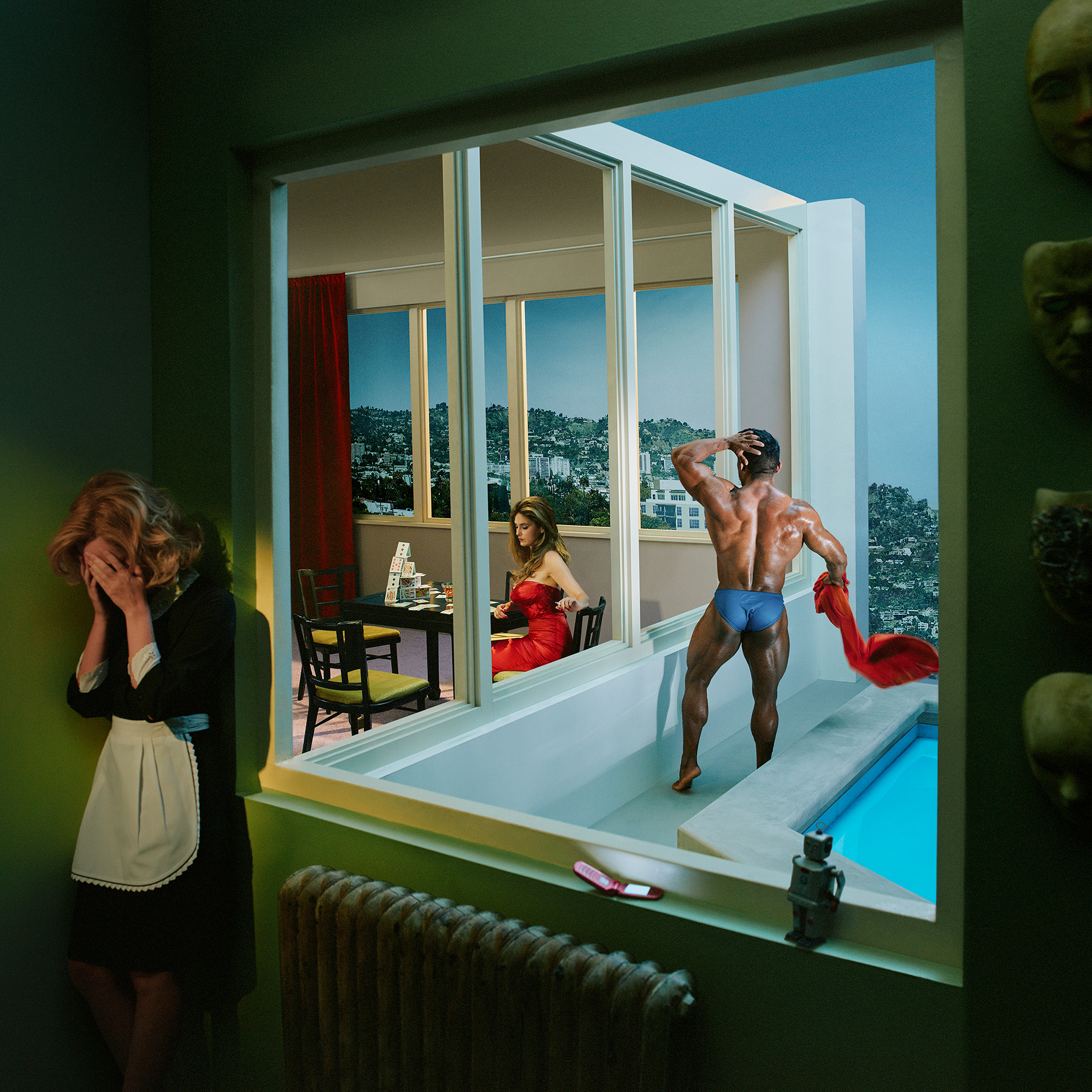
We checked in with our former podcast guests who will be inching through Miami traffic, unveiling new works, signing books and revealing new projects this year.
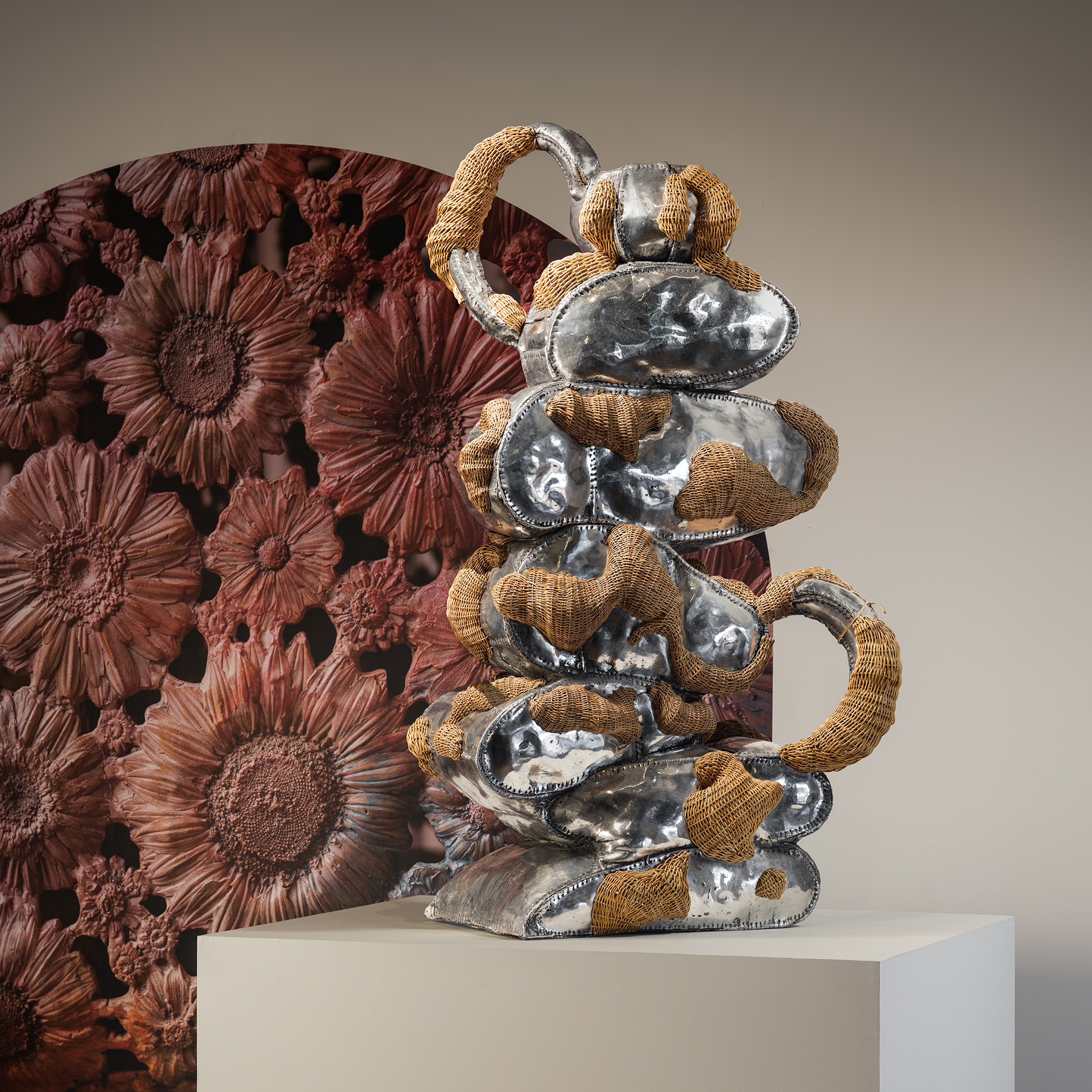
The ecstatic designs of Chris Wolston come to Texas, Juergen Teller's most honest show yet opens in Athens, a forgotten Cuban Modernist is revived in New York, and more.
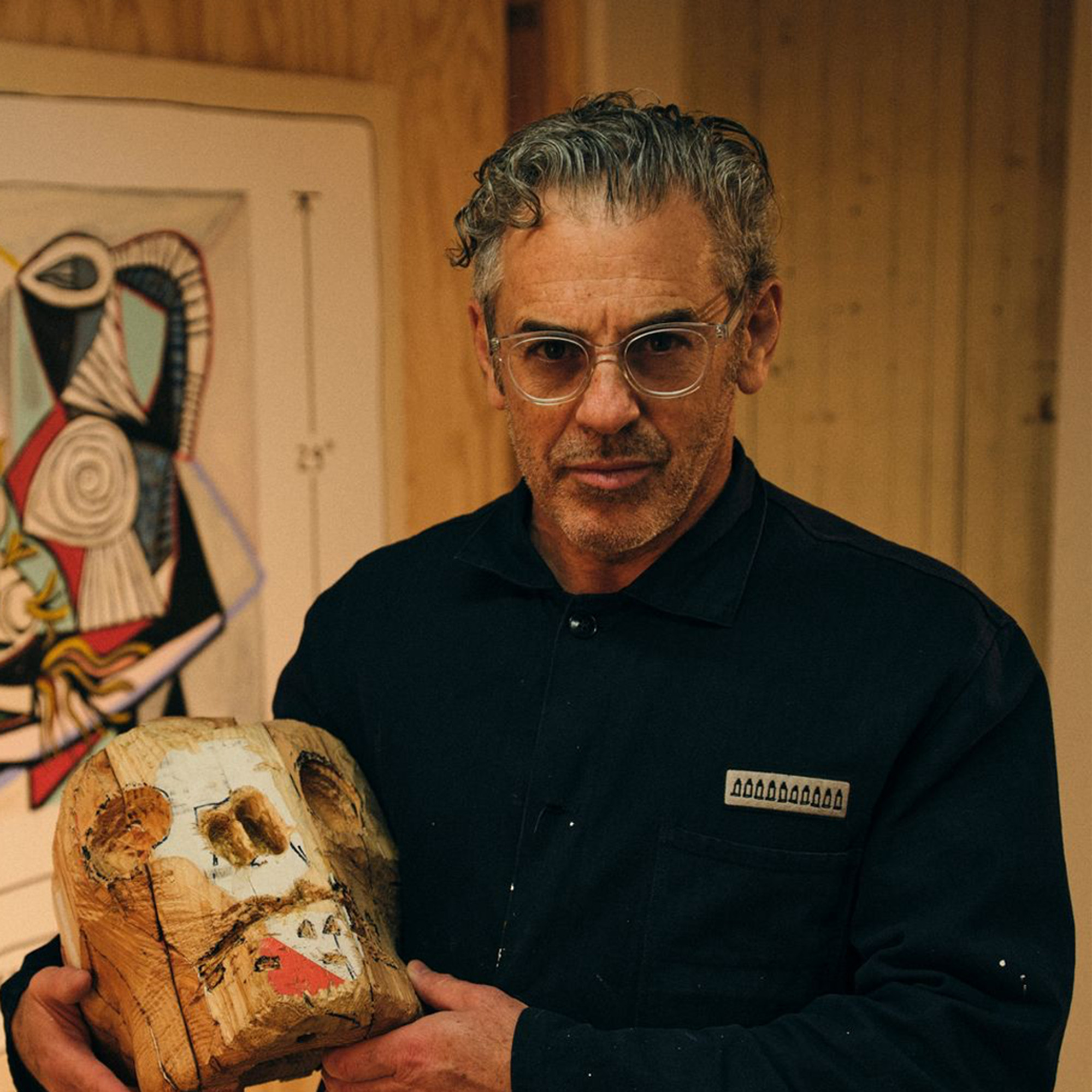
Tom Sachs explores various creative disciplines, from sculpture and filmmaking to design and painting. On this season finale, Dan speaks with Tom about his accidental journey to fine art, how an installation in a Barneys window kickstarted his career, and more.